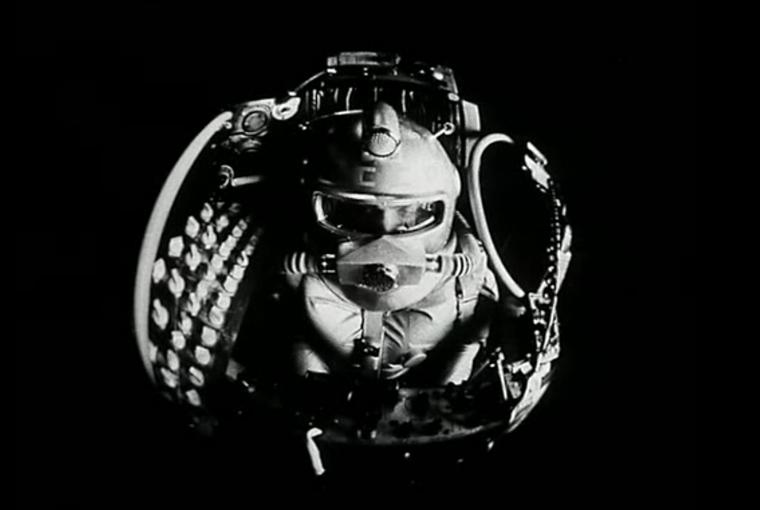History Revised
Alexei Fedorchenko’s First on the Moon (Pervye na Lune, 2005)
Vol. 5 (May 2011) by Konstanty Kuzma
In First on the Moon, Aleksei Fedorchenko tells the story of a fictional, secret moon landing by the Soviet Union in 1938 in a prime example of mockumentary filmmaking. Supposed secret archive footage from a space ship wreck found in Chile reveals that the Soviet Union succeeded in carrying out a space landing 31 years prior to the U.S. Apollo 11 mission. What might sound as a dream to any Soviet communist is in fact a take on Soviet romanticism and retro-futurism. First on the Moon is a stylistically driven combination of archive footage and shot sequences that – in this film – remain as inseparable as truth and fiction. By doing so, Fedorchenko connects idealist Soviet aesthetics with absurd humor and imagery resulting in an entertaining stylistic mash-up.
The story follows the fate of the Soviet space crew from the beginnings of the mission’s existence. The film is split up into episodes that concentrate on the people involved in the mission who were tailed by the NKVD (a forerunner of the KGB). When the mission is launched, the crew disappears, and the ambitions of the Soviet Union for a lunar mission are covered up (it is documented that there were actual ambitions for a lunar mission in the Soviet Union in the 1960s). After a few years, the members of the crew appear in different parts of the world with severe injuries from the mission, unacknowledged for their achievements for the Soviet Union. Ivan Kharlamov – the hero of the crew – is sighted in a circus somewhere in the Soviet Union performing as a brave Russian knight fighting Germans. This dimension is probably the only one that is idealistic in the classical sense: the logic of the film implies that silent heroes live among us. Due to the fact that in this film the regime shows no interest in supporting these silent heroes, the mission to space becomes a pluralistic work of the collective – an image that fits perfectly in the pathos of the film. However, it is disappointing that in his story, Fedorchenko misses the opportunity to illustrate why the Soviet Union did not exploit their monumental achievement, and why their ambitions for another lunar mission were ambiguously dropped after the failure of the moon mission. Even if an explanation would not have brought the story any closer to the truth, it might have made the fiction more believable.
The mockumentary film is closely linked to the aesthetics of modern horror and sci-fi genres, as all three depend on a style that suggest the reality of an otherwise unimaginable event (e.g. District 9 (2009), The Blair Witch Project (1999), Paranormal Activity (2007), Cloverfield (2008)). Of course, First on the Moon works with a different approach, but nevertheless, the form of the film nearly merges with its content. We are confronted with the seemingly banal fact that something that is presented as the truth is not necessarily so. Notably, if one looks at certain tendencies of mass media in the United States or, in this case, Russia, the mockumentary genre appears to be well-grounded. However, an integral problem of the genre is that this notion is usually not sufficient for entertaining an audience in a feature-length film (which might be the reason why Peter Jackson did not make Forgotten Silver (1995) into a feature). Fedorchenko does not attempt to make the audience believe that what they witness has any connection to reality. There is nothing that the audience realizes by watching the film and thus no tension drives the story. Watching First on the Moon is like a meditative experience without ups or downs. The images – in spite of their intensity – seem as shallow as the story they stand for.




Leave a Comment